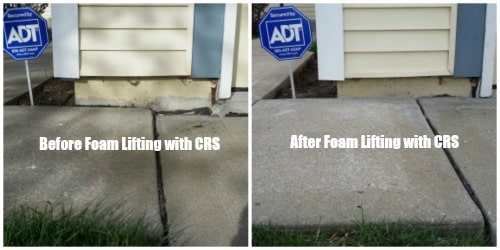Table of Contents
Some homeowners are aware that if the driveway has a lot of cracks in it or if the driveway has pulled away from the garage. This is an indication there is a problem. You may be aware of the term “mud jacking.” You may have seen large, heavy cement trucks in your neighborhood and spoken with other neighbors about the procedure for mud jacking. Mud jacking is a process that utilizes a mixture of water, dirt, and cement that is pumped into large holes drilled into the concrete to level the cement slabs in a driveway that are cracking or falling away from the garage. This process of mud jacking has been around since the early 1900s. Wikipedia, barely mentions the outdated method of utilizing a “mud-like” substance. But it does provide a lot of information on the most modern methodology using ‘foam’ as the expanding concrete levelling choice.
Where can you use Lifting Concrete with Foam?
One of the major benefits of foam lifting is the smaller, lighter equipment that is used in this process. Due to these characteristics lifting a concrete sidewalk between buildings, such as an apartment, condominium complex or school, is much easier for foam lifting companies. The hose and nozzle used to inject the 2-part polymer process can reach these hard to get to places. Traditional mud jacking requires heavy equipment. This equipment must be driven to the concrete in need of repair. As careful as the workers may be, it is sometimes unavoidable that this process can destroy grass or landscaping.
Use foam to repair a sunken Garage and Basement Floor
Concrete slabs exposed to the elements, such as rain and snow, may seem to be more susceptible to sinking. A garage or basement floor can also sink or have a void beneath it and be repaired with foam lifting. A basement floor or a garage floor that has a void under it will sound hollow when you walk on it or tap it with a bat or broom handle.
Is there any damage to the concrete during the lifting process with foam?
Small holes must be drilled into the concrete that needs repair in the process of foam lifting. However, in comparison to traditional mud jacking, the number of holes used in foam lifting is less, and the size of the hole is smaller. Compare the traditional mud jacking hole size of 2-3” with a foam lifting hole size of 3/8-5/8.”

How much does foam jacking cost?
Lifting sunken concrete with foam will be less expensive than replacing your concrete. On average, it will cost 40% less to repair concrete with foam lifting than to replace sunken concrete. When comparing foam lifting to traditional mud jacking costs, a homeowner may find similar quotes. However, a striking advantage foam has over traditional mud jacking is that the foam is impervious to water, weather and compacting soil. It takes approximately 30 minutes for the polyurethane foam to cure and stay in place. Due to the nature of the mud jacking material- cement, water, and dirt- compaction due to a dry climate and lack of rain may cause the soil to sink once again. Thus the repaired concrete will need to be lifted and repaired again.
How do I know if my concrete can be lifted or replaced?
The only way to know if your concrete can be lifted or is beyond repair is to have the sunken concrete evaluated by a professional. (You can also read more about the signs of a sinking basement, pool deck, or steps) Call Ken at Concrete Raising Systems. Ken and Jason have been in the foam lifting business since 2013. The Concrete Raising Systems owners come from the home building profession and can also assess if there is an underlying problem that may need to be addressed before the concrete is repaired. Ken and Jason’s customers have found them to be honest and ethical. You will too.
This article was originally published in April 2016 and has been updated.
